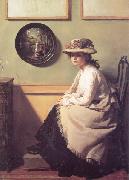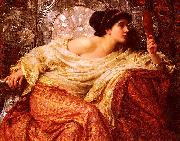Wholesale Oil Painting No Minimum |
|||||||||||
|
|
|||||||||||

|
|||||||||||
|
|
|
||||||||
Sir William OrpenIrish 1878-1931 Sir William Orpen Location Irish painter. He attended the Metropolitan School of Art, Dublin (1891-7), and the Slade School of Art, London (1897-9), there winning the composition prize of 1899 with The Play Scene from Hamlet (Houghton Hall, Norfolk). He became a friend of Augustus John and joined the New English Art Club. From very early years he had been an impassioned student of the Old Masters, and he went to Paris with John in 1899 to see Leonardo da Vinci Mona Lisa (Paris, Louvre). In the following years his perception of their works |
||||||||
|
|
||||||||
The Mirror
The Mirror Painting ID:: 26447 |
mk50
1900 mk50 1900 |
|||||||
|
|
||||||||
John William GodwardEnglish 1861-1922 Godward was a Victorian Neo-classicist, and therefore a follower in theory of Frederic Leighton. However, he is more closely allied stylistically to Sir Lawrence Alma-Tadema, with whom he shared a penchant for the rendering of Classical architecture, in particular, static landscape features constructed from marble. The vast majority of Godward's extant images feature women in Classical dress, posed against these landscape features, though there are some semi-nude and fully nude figures included in his oeuvre (a notable example being In The Tepidarium (1913), a title shared with a controversial Alma-Tadema painting of the same subject that resides in the Lady Lever Art Gallery). The titles reflect Godward's source of inspiration: Classical civilisation, most notably that of Ancient Rome (again a subject binding Godward closely to Alma-Tadema artistically), though Ancient Greece sometimes features, thus providing artistic ties, albeit of a more limited extent, with Leighton. Given that Classical scholarship was more widespread among the potential audience for his paintings during his lifetime than in the present day, meticulous research of detail was important in order to attain a standing as an artist in this genre. Alma-Tadema was, as well as a painter, an archaeologist who attended historical sites and collected artefacts that were later used in his paintings: Godward, too, studied such details as architecture and dress, in order to ensure that his works bore the stamp of authenticity. In addition, Godward painstakingly and meticulously rendered those other important features in his paintings, animal skins (the paintings Noon Day Rest (1910) and A Cool Retreat (1910) contain superb examples of such rendition) and wild flowers (Nerissa (1906), illustrated above, and Summer Flowers (1903) are again excellent examples of this). The appearance of beautiful women in studied poses in so many of Godward's canvases causes many newcomers to his works to categorise him mistakenly as being Pre-Raphaelite, particularly as his palette is often a vibrantly colourful one. However, the choice of subject matter (ancient civilisation versus, for example, Arthurian legend) is more properly that of the Victorian Neoclassicist: however, it is appropriate to comment that in common with numerous painters contemporary with him, Godward was a 'High Victorian Dreamer', producing beautiful images of a world which, it must be said, was idealised and romanticised, and which in the case of both Godward and Alma-Tadema came to be criticised as a world-view of 'Victorians in togas'. |
||||||||
|
|
||||||||
|
|
The Mirror
The Mirror Painting ID:: 67866 |
1899(1899)
Oil on canvas
31 5/8 X 14 3/4 inches (80.6 X 37.5 cm)
1899(1899) Oil on canvas 31 5/8 X 14 3/4 inches (80.6 X 37.5 cm) |
||||||
|
|
||||||||
William Orpen1870-1943 |
||||||||
|
|
||||||||
|
|
The Mirror
The Mirror Painting ID:: 70451 |
Medium Oil on canvas
Dimensions Expression error: Missing operand for *50.8 ?? 40.6 cm
Medium Oil on canvas Dimensions Expression error: Missing operand for *50.8 ?? 40.6 cm |
||||||
|
|
||||||||
Frank Bernard Dicksee(b. London, 27 November 1853 - 17 October 1928) was an English Victorian painter and illustrator, best known for his pictures of dramatic historical and legendary scenes. He also was a noted painter of portraits of fashionable women, which helped to bring him success in his own time. Dicksee's father, Thomas Dicksee, was a painter who taught Frank as well as his brother Herbert and his sister Margaret from a young age. Dicksee enrolled in the Royal Academy in 1870 and achieved early success. He was elected to the Academy in 1891 and became its President in 1924. He was knighted in 1925, and named to the Royal Victorian Order by King George V in 1927. Dicksee painted the piece 'The Funeral of a Viking' in 1893, which now resides in Manchester City Art Gallery, having been there since 1928 when it was presented by Arthur Burton ESQ in memory of his mother to the Corporation of Manchester. Victorian critics gave it both positive and negative reviews, for its perfection as a showpiece and for its dramatic and somewhat staged setting, respectively. The painting was used by Swedish Viking/Black metal band Bathory for the cover of their 1990 album, Hammerheart. |
||||||||
|
|
||||||||
|
|
The Mirror
The Mirror Painting ID:: 72147 |
1896(1896)
Oil on canvas
37 1/2 X 46 3/8 inches (95.3 X 118.1 cm)
cjr 1896(1896) Oil on canvas 37 1/2 X 46 3/8 inches (95.3 X 118.1 cm) cjr |
||||||
|
|
||||||||
|
Frank Bernard Dicksee (b. London, 27 November 1853 - 17 October 1928) was an English Victorian painter and illustrator, best known for his pictures of dramatic historical and legendary scenes. He also was a noted painter of portraits of fashionable women, which helped to bring him success in his own time. Dicksee's father, Thomas Dicksee, was a painter who taught Frank as well as his brother Herbert and his sister Margaret from a young age. Dicksee enrolled in the Royal Academy in 1870 and achieved early success. He was elected to the Academy in 1891 and became its President in 1924. He was knighted in 1925, and named to the Royal Victorian Order by King George V in 1927. Dicksee painted the piece 'The Funeral of a Viking' in 1893, which now resides in Manchester City Art Gallery, having been there since 1928 when it was presented by Arthur Burton ESQ in memory of his mother to the Corporation of Manchester. Victorian critics gave it both positive and negative reviews, for its perfection as a showpiece and for its dramatic and somewhat staged setting, respectively. The painting was used by Swedish Viking/Black metal band Bathory for the cover of their 1990 album, Hammerheart. The Mirror 1896(1896) Oil on canvas 37 1/2 X 46 3/8 inches (95.3 X 118.1 cm) cjr |
||||||||
|
|
||||||||
|
Prev Next
|
||||||||
|
|
||||||||
|
Related Paintings to Frank Bernard Dicksee :. |
||||||||
|
|
||||||||
|
CONTACT US |




